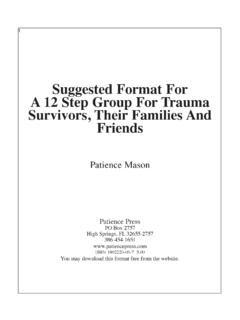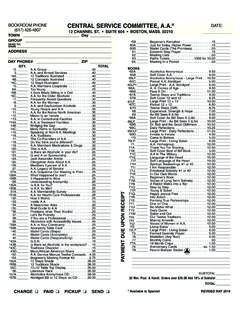Transcription of N FPA 30 - nioec.org
1 NFPA 30 Flammable and Combustible Liquids Code 2003 Edition Copyright 2003, National Fire Protection Association, All Rights Reserved This edition of NFPA 30, Flammable and Combustible Liquids Code, was prepared by the Technical Committees involved with the Flammable and Combustible Liquids project, released by the Technical Correlating Committee on Flammable and Combustible Liquids, and acted on by NFPA at its May Association Technical Meeting held May 18 21, 2003, in Dallas, TX. It was issued by the Standards Council on July 18, 2003, with an effective date of August 7, 2003, and supersedes all previous editions. This edition of NFPA 30 was approved as an American National Standard on July 18, 2003. Origin and Development of NFPA 30 From 1913 to 1957, this document was written as a model municipal ordinance known as the Suggested Ordinance for the Storage, Handling, and Use of Flammable Liquids.
2 In 1957, the format was changed to a code, although the technical requirements and provisions remained the same. During the 90 year period of existence of NFPA 30, numerous revised editions have been published as dictated by experience and advances in technology. A brief review of the major changes adopted over the previous six editions follows. In 1984, the chapter covering automotive and marine service stations was removed from NFPA 30 and was used as the basis for a separate document, NFPA 30A, Automotive and Marine Service Station Code, now titled Code for Motor Fuel Dispensing Facilities and Repair Garages. In 1987, Chapter 5 (Industrial Plants), Chapter 6 (Bulk Plants and Terminals), Chapter 7 (Process Plants), and Chapter 8 (Refineries, Chemical Plants, and Distilleries) were combined into a single chapter on operations.
3 In 1990, a new section was added to Chapter 4 to address hazardous materials storage lockers, and more detailed guidance was added to Section 5 3 to address ventilation of enclosed process areas and for estimation of fugitive emissions. In 1993, Chapter 4, Container and Portable Tank Storage, was completely rewritten so that its requirements were presented more clearly, especially for mercantile occupancies. In addition, changes were made to the tank diking provisions to allow combined remote impounding and diking systems and to provide relief from the spill control requirements for certain secondary containment type tanks. In 1996, the following major changes were incorporated: requirements for temporary and permanent closure of underground storage tanks requirements for tightness testing of tanks Copyright NFPA of specific design recognition of intermediate bulk containers mandatory fire protection design criteria for inside storage of liquids.
4 In 2000, the following major changes were incorporated: complete editorial rewrites of Chapter 2, Tank Storage, and Chapter 3, Piping Systems requirements for vaults for aboveground tanks and for protected aboveground tanks recognition of specific nonmetallic intermediate bulk containers for Class II and Class III liquids, along with fire protection system design criteria simplified spill containment and drainage requirements new fire protection design criteria for a number of flammable and combustible liquid commodities expansion of the requirements in Subsection for construction and separation of process buildings new Section was added to address recirculating heat transfer fluid heating systems new Section was added to address solvent recovery distillation units consolidation into a new Chapter 6 of all requirements for hazardous location electrical area classification.
5 This 2003 edition of NFPA 30 incorporates the following changes: (1) All mandatory referenced publications have been consolidated into a new Chapter 2 and all definitions into a new Chapter 3. All subsequent chapters have been renumbered accordingly. (2) Numerous occupancy definitions have either been added or corrected to correlate with NFPA 1, Uniform Fire Code NFPA 101 , Life Safety Code and NFPA 5000 , Building Construction and Safety Code . (3) Separation distance requirements have been reduced in Table (a) for protected aboveground tanks, and separation distance requirements for tanks in vaults constructed in accordance with have been eliminated. (4) Special operating requirements have been added in for shop fabricated aboveground tanks with abnormally long vertical piping for fill and/or vent lines.
6 (5) New criteria have been added for maximum allowable container sizes in Table and in appropriate paragraphs of Chapter 6. (6) A new Table (k) contains fire protection design criteria for unsaturated polyester resins, including appropriate amendments to Figure (a) and Figure (7) A new Annex contains suggested fire protection design criteria using high expansion foam systems for protection of liquids in 1 gallon plastic containers. (8) Revisions have been made to the Section spacing requirements and construction requirements for process buildings. (9) Special requirements have been added in Section for insulated piping for recirculating heat transfer systems. (10) A new provides guidance prohibiting permanent interconnections between fire water systems and process water systems.
7 Technical Correlating Committee on Flammable and Combustible Liquids Copyright NFPA Edward Hildebrandt, Chair Village of Morton Grove, IL [E] John A. Davenport, West Point, VA [I] James D. Kieffer, Kieffer & Associates, Inc., Canada [SE] Richard S. Kraus, Petroleum Safety Consultants, VA [M] Rep. American Petroleum Institute William E. Rehr, BOCA International, Inc., IL [E] Douglas A. Rivers, 3M Company, MN [U] Orville M. Slye, Jr., Loss Control Associates Inc., PA [SE] Hugh Patrick Toner, Society of the Plastics Industry, Inc., DC [M] Alternates Clark D. Shepard, ExxonMobil Corporation, VA [M] (Alt. to R. S. Kraus) Nonvoting David L. Blomquist, Blomquist Fire Protection Engineering, CA (Member Emeritus) Gary R. Glowinski, Glowinski & Associates, Inc.
8 , WI [SE] Donald M. Johnson, Walnut Creek, CA (Member Emeritus) Anthony M. Ordile, Loss Control Associates, Inc., PA Brooke B. Smith, Jr., Aspen Engineering Inc., CO Jack Woycheese, Hughes Associates, Inc., CA Robert P. Benedetti, NFPA Staff Liaison This list represents the membership at the time the Committee was balloted on the final text of this edition. Since that time, changes in the membership may have occurred. A key to classifications is found at the back of the document. NOTE: Membership on a committee shall not in and of itself constitute an endorsement of the Association or any document developed by the committee on which the member serves. Copyright NFPA Committee Scope: This Committee shall have primary responsibility for documents on safeguarding against the fire and explosion hazards associated with the storage, handling, and use of flammable and combustible liquids and classifying flammable and combustible liquids.
9 Technical Committee on Fundamentals (FLC FUN) Gary R. Glowinski, Chair Glowinski & Associates, Inc., WI [SE] Robert P. Benedetti, Nonvoting Secretary NFPA, MA Gerald A. Gordon, Greif Brothers Corporation, IL [M] Dwight H. Havens, City of Phoenix Fire Department, AZ [E] Jay J. Jablonski, HSB Professional Loss Control, TX [I] James D. Kieffer, Kieffer & Associates, Inc., Canada [SE] Richard S. Kraus, Petroleum Safety Consultants, VA [M] Jack Woycheese, Hughes Associates, Inc., CA [SE] Cherilyn A. Zeisset, Pennzoil Quaker State Company, TX [M] Alternates Peter R. Apostoluk, Greif Brothers Corporation, IL [M] (Alt. to G. Gordon) Joseph L. Scheffey, Hughes Associates, Inc. MD [SE] (Alt. to J. Woycheese) Kenneth H. Turnbull, Texaco, TX [M] (Alt.)
10 To R. S. Kraus) Robert P. Benedetti, NFPA Staff Liaison This list represents the membership at the time the Committee was balloted on the final text of this edition. Since that time, changes in the membership may have occurred. A key to classifications is found at the back of the document. NOTE: Membership on a committee shall not in and of itself constitute an endorsement of the Association or any document developed by the committee on which the member serves. Committee Scope: This Committee shall have primary responsibility for documents or portions of documents on the basic requirements for safeguarding against the fire and Copyright NFPA explosion hazards associated with the storage and handling of flammable and combustible liquids.


